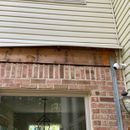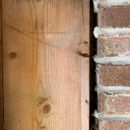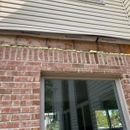Sealing between brick and rim joist
saw a couple posts on this topic, but I was not sure they are talking about the same thing. I have had an issue with chipmunks getting between the ceiling of the first floor and the floor of the 2nd. When I investigated how they get in I found a large gap between the rim joist and the brick veneer of the house.
Can this area be sealed, does the gap need to allow for breathing behind the brick? I am keeping critters out with a cap at the corners of the siding. Should resolve the issue, now I am concerned with moisture spots on the ceiling and the large gap. They are probably related.
GBA Detail Library
A collection of one thousand construction details organized by climate and house part













Replies
Brick and stone are not impermeable and will absorb water. Code requires a one inch gap between the brick and the wood so any water that gets to the back side of the brick will evaporate in the air gap and escape into the air gap. If you fill the gap with foam, water is likely wick up thru the foam and getting the wood wet and rotting the wood away.
If you think rodents are getting the gap I would put in aluminum Z shaped flashing on the wall behind the siding and over the top of the brick
To my eye it looks like the builder did not put sheeting on the wall behind the brick.
Walta
Hi, that gap serves a purpose. Brick veneer needs ideally at least a 1" air space behind it for ventilation. The channel allows liquid water to drain out through the weep holes but it also prevents solar vapor drive. This is when it rains, the brick gets wet, then the sun comes out and drives that vapor into your wall cavities where it might then condense on interior surfaces, for example if you are air conditioning in the summer.
Where are you seeing the moisture spots? Are they near the wall ceiling intersection or more in the middle?
In the third picture, is that pink insulation that I'm seeing behind the brick? If so, you might want to think about whether you can seal that up somehow while leaving the ventilation gap for the brick. Not only is a spot where critters can get in but it's probably also a huge source of air leakage. The moisture might be related to this air leakage (e.g., warm-moist house air coming into contact with cold surfaces in winter or warm-moist outside are coming into contact with cooler air conditioned air in summer). It could also be a flashing issue. I didn't see any flashing that would kick water running down the vinyl siding out and away from the brick. If it lands on top of the brick, it might be able to find its way into your house. But maybe you removed that flashing when you lifted up the siding.
If it were me, I would be inclined to call in a mason to remove the top course of brick (and reinstall it later) in order to get access to seal the area with pink insulation up and install proper flashing to make sure rain drains out away from the brick.
If you're not inclined to do that you might be able to add further security against critters by putting in a vent into that gap that has holes that are too small for critters to get through. Something like Coravent might work. But that wouldn't solve the air leakage or moisture problems.
-Patrick
Thank you for info, I guess that foam is coming back out.
I did remove the flashing to access the gap.
Here are the moisture issues, this is on the interior of the same wall. Ceiling was repainted about 1 year ago.
To my eye that pattern seems a bit too random to be caused by a water infiltration problem but it can't be ruled out. You could check those spots with a moisture meter to see how wet they actually are compared to the spots that are not discoloured.
But there's possibly a simpler explanation...it might be rodent urine. Sometimes those types of stains keep leaching through after repainting. You might try using some kind of stain blocking primer and see if that fixes the problem.